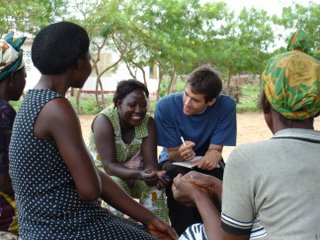 1. I hope for the LDS brand, Helping Hands, to become synonymous with disaster relief.
1. I hope for the LDS brand, Helping Hands, to become synonymous with disaster relief. I think disaster relief is a natural fit for the LDS Church and its members, both in terms of values and playing to the strengths of the organizational efficiency of the Church. I would love to see the church brand of Helping Hands to become as synonymous with disaster relief as the Red Cross but with a more impressive response time and army of volunteers.
2. I hope for LDS Philanthropies to become known in wider circles for Health and Education.
Institutionally the LDS Church has already defined itself according to these two issue areas: focusing on health in their humanitarian work (emphasis areas in clean water, neonatal resuscitation training, wheelchair distribution and vision treatment), and then by focusing on education through the Perpetual Education Fund and the various church-sponsored universities and colleges, which are no doubt the biggest expenses in the LDS Philanthropies budget.
If the Church or its members were to become more involved in the wider circles of health and education I would suggest a number of high-impact organizations with whom the Church could partner with/support financially and/or view them as implementers of the Church's philanthropic goals:
Whirlwind Wheelchair: (Disabilities) appropriate design for conditions in poor countries.
Path and PSI (Health; focus on utilizing market mechanisms)
Room to Read: (Education; strong focus on enabling local publishers in local languages)
VisionSpring (Vision; business-in-a-backpack reading glasses)
OneWorldHealth (Health; first nonprofit pharmaceutical company, making medicine for the diseases of the poor that are currently not financially attractive to the large multinational corporations)
Sprinkles (Health; simple product that can provide great returns in terms of malnutrition, the largest killer of children under 5)
3. NEW Packaging: LDS philanthropists should brand themselves around family-based interventions.
This is somewhat already happening but it is not being articulated and I think if it were articulated clearly, the community of LDS philanthropists could introduce a new paradigm into philanthropy and one that is perfectly aligned with LDS values. Potential investments:
- Microfinance. This is already a favorite investment for the LDS community; they have been involved with Grameen and FINCA from the beginning; UNITUS, the microfinance accelerator, which has received rave reviews, was started by a group of LDS businessmen. But the articulation piece is recognizing the power of microfinance in terms of household income and the % of the loan that goes directly to the family. Another organization to keep on our micorfinance radars: Microfinance International Corporation, creatively using remittances and the formal banking system to fuel microfinance.
- Renascer. Vera Corderio's family based model of health care in Brazil, focused on reducing readmission. She is one of the most high-touted social entrepreneurs, found early and elected an Ashoka Fellow in 1992, AVINA leader in 2000, Schwab social entrepreneur in 2001, Global Development's "Most Innovative" project in 2002, Skoll Award for Social Entrepreneurship in 2006. For an overview, listen to Vera on Social Innovations Conversations, or watch a video of her work.
- A sample of recently elected Ashoka Fellows working with family-based strategies: Dariusz Cupail (Poland-supporting fathers as a key part of a family); Sylvia Reyes (Ecuador-traces various societal problems to the home and works with the entire family); Indira Ranamagar (Nepal-reintegration of prisoners into society by focusing on their roles in families); Marli Marcia da Silvia (Brazil-supporting single mothers and encouraging fathers to be responsible for their children), Katarzyana Oles (Poland- family-centered obstetrics system).
4. LDS members and philanthropists should engage more fully in the wider efforts of philanthropy.
I think the Mormons can bring great strength and insight into the world of philanthropy but for a host of historical and cultural reasons I believe they remain largely outside of influential circles in terms of leadership, employment, and activism in addressing the toughest social problems of our times. I think LDS members should be encouraged to be active in service organizations outside of the Church and the Church should make concentrated efforts to involve the public-at-large in their humanitarian work. I also think LDS philanthropists can bring great respect and dignity to the Church by being active in the wider circles of philanthropy, which is correlated to my last point...
5. LDS businessmen should lead the way in integrating business and philanthropy.
Mormons have made a name for themselves in business, they fill leadership positions at the Harvard Business School, they have a highly ranked business school themselves, and some of the most highly visible Mormons are businessmen. There is a world-wide trend in philanthropy that is borrowing the efficiencies and operations of business and applying them in the social sector. LDS business leaders and LDS business schools should be out in front championing this movement.


No comments:
Post a Comment